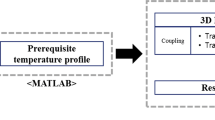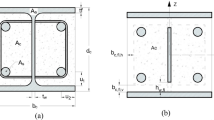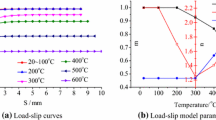Abstract
The thermal buckling of an axially restrained composite column that is exposed to a heat flux due to fire is studied by both analytical and experimental means. The column is exposed to fire from one-side and the resulting heat damage, the charred layer formation and non-uniform transient temperature distribution are calculated by the thermal model developed by Gibson et al. (Revue de l’Institute Francais du Petrole 50:69–74, 1995). For the thermal buckling analysis, the mechanical properties of the fire-damaged (charred) region are considered negligible; the degradation of the elastic properties with temperature (especially near the glass transition temperature of the matrix) in the undamaged layer, is accounted for by using experimental data for the elastic moduli. Due to the non-uniform stiffness and the effect of the ensuing thermal moment, the structure behaves like an imperfect column, and responds by bending rather than buckling in the classical Euler (bifurcation) sense. Another important effect of the non-uniform temperature is that the neutral axis moves away from the centroid of the cross section, resulting in another moment due to eccentric loading, which would tend to bend the structure away from the fire. In order to verify the mechanical response, the compressive buckling behavior of the same material subjected to simultaneous high intensity surface heating and axial compressive loading were investigated experimentally. Fire exposure was simulated by subjecting the surface of rectangular specimens to radiant heating in a cone calorimeter. Heat flux levels of 25 kW/m2, 50 kW/m2 and 75 kW/m2 were studied. All specimens exhibited buckling and subsequent catastrophic failure, even at compressive stresses as low as 3.5 MPa under a surface heat flux of 25 kW/m2. Details of the experimental procedure, including modifications made to a cone calorimeter to allow simultaneous mechanical loading are presented.





















Similar content being viewed by others
Notes
100 mm was the maximum length over which uniform heating could be obtained in the cone calorimeter.
References
U. Sorathia, C.M. Rollhauser and W.A. Hughes, ‘Improved fire safety of composites for naval applications’, Fire & Materials, 16, (1992), 119-25.
U. Sorathia, R. Lyon, R. Gann and L. Gritzo, ‘Materials and fire threat’, SAMPE Journal, 32, (1996), 8-15.
G.T. Egglestone and D.M. Turley D.M., ‘Flammability of GRP for use in ship superstructures’, Fire & Materials, 18, (1994), 255-60.
M.J. Scudamore, ‘Fire performance studies on glass-reinforced plastic laminates’, Fire & Materials, 18, (1994), 313-25.
J.R. Brown and Z. Mathys, ‘Reinforcement and matrix effects on the combustion properties of glass reinforced polymer composites’, Composites, 28A, (1997), 675-81.
A.P. Mouritz and C.P. Gardiner, ‘Compression properties of fire-damaged polymer sandwich composites’. Composites, 33A, (2002), 609-620.
J.B. Henderson, J.A. Wiebelt and M.R. Tant, ‘A model for the thermal response of polymer composites materials with experimental verification’, Journal of Composite Material, 19, (1985), 579-595.
A.G. Gibson, Y.S. Wu, H.W. Chandler, J.A.D. Wilcox and P. Bettess, ‘A model for the thermal performance of thick composite laminates in hydrocarbon fires’, Revue de l’Institute Francais du Petrole, 50, (1995), 69-74.
M.R.E. Looyeh, P. Bettess and A.G. Gibson, ‘A one-dimensional finite element simulation for the fire-performance of GRP panels for offshore structures’, International Journal of Numerical Methods for Heat and Fluid Flow, 7, (1997), 609-625.
A.G. Gibson, P.N.H. Wright, Y.S. Wu, A.P. Mouritz and Z. Mathys, ‘Modelling residual mechanical properties of polymer composites after fire’, Plastics, Rubbers and Composites: Processing & Applications, 32, (2003), 81- 90.
A.P. Mouritz and Z. Mathys Z., ‘Post-fire mechanical properties of glass-reinforced polyester composites’, Composites Science and Technology, 61, (2001), 475-490.
Kulkarni AP, Gibson RF (2003) Nondestructive characterization of effects of temperature and moisture on elastic moduli of vinyl ester eesin and E-glass/vinyl ester composite. In: Proceedings of the American Society of Composites 18th annual technical conference. Florida
H. Huang and G.A. Kardomateas, ‘Buckling and initial postbuckling behavior of sandwich beams including transverse shear’, AIAA Journal, 40, (2002), 2331-2335.
A.G. Gibson, A.P. Mouritz and Z. Mathys Z, ‘The integrity of polymer composites during and after fire’, Journal of Composite Materials, 38, (2004), 1283-1306.
Liu L, Holmes JW (2007) Experimental investigation of the buckling of polymeric composites during high simultaneous heat flux exposure and compressive loading. J Compos Mater 41(2):211–241
Liu L (2006) Durability of polymer composite materials, PhD Thesis, School of Aerospace Engineering, Georgia Institute of Technology, Atlanta, GA
Liu L, Kardomateas GA, Birman V, Holmes JW, Simitses GJ (2006) Thermal bending of a heat exposed, axially restrained composite column. Compos Part A 37(7):972–980. (Special Issue on Fire Behaviour of Composites)
Bausano JV, Boyd SE, Lesko JJ, Case SW (2004) Composite life under sustained compression and one sided simulated fire exposure: characterization and prediction. In: Composites 2004 convention and trade show American Composites Manufacturers Association. Tampa, FL
Acknowledgments
The financial support of the Office of Naval Research, Grant N00014-03-1-0189, and the interest and encouragement of the Grant Monitor, Dr. Luise Couchman, is gratefully acknowledged.
Author information
Authors and Affiliations
Corresponding author
Rights and permissions
About this article
Cite this article
Liu, L., Holmes, J.W., Kardomateas, G.A. et al. Compressive Response of Composites Under Combined Fire and Compression Loading. Fire Technol 47, 985–1016 (2011). https://doi.org/10.1007/s10694-009-0123-7
Published:
Issue Date:
DOI: https://doi.org/10.1007/s10694-009-0123-7




